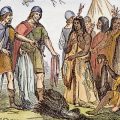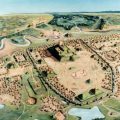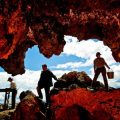
As a cultural area, the Southern Plains is bounded by the Arkansas River on the north, the Rocky Mountains on the west, the Mississippi River on the east, and the Balcones Escarpment on the south. The area presently known as Texas covers much of the Southern Plains. In general, this is a grassy area with forests found along the streams.
American Indians lived in Texas for many thousands of years prior to the European invasion. The period of time prior to 8,000 BCE is often called the Paleo-Indian Period and the era from 8,000 to 5,000 BCE is known as the Early Mobile Foraging Period. During these time periods, American Indian groups were primarily nomadic hunters. Since there were very few plant foods with nutritional value for humans, these early Indian groups depended largely on hunting for their subsistence. Archaeologist Susan Vehik, in her chapter in the Handbook of North American Indians, reports:
“Large and small animal resources were utilized prehistorically. Bison are commonly assumed to be the primary animal resource, but the Southern Plains experienced pronounced fluctuations in the size and distribution of bison herds.”
Susan Vehik also reports:
“Bison herds are a clumped and unpredictable resource compared to deer and other small animals that tend to be dispersed. This distinction has implications for the size and distribution of human social groups.”
About 5000 BCE, the Great Plains began to enter into a climate period known as the Altithermal which is a hot, dry episode that lasted for about 2,500 years. In the Southern Great Plains this marked the transition from the Early Mobile Foraging Period to the Late Mobile Foraging Period.
Briefly described below are some of the archaeological sites in Texas which date prior to 5000 BCE.
Paleo-Indian Period
During the Paleo-Indian Period, Indian people on the Plains were nomadic hunter-gatherers. With regard to the stone technology used on the Plains during the Paleo-Indian Period, Douglas Bamforth, in his entry on the Plains in the The Oxford Companion to Archaeology, reports:
“The Paleo-Indian period on the Plains is also well-known for the sophistication of its stoneworking: Projectile points in particular are extremely well-crafted, aesthetically pleasing, and difficult to produce, and Paleo-Indian flint knappers tended to manufacture them from very high-quality stone.”
Petronila Creek: by 16,000 BCE, Indian people were occupying a hunting and fishing camp on Petronila Creek. They were hunting mammoth, ground sloth, camel, horse, peccary, antelope, coyote, prairie dog, and alligator. They were fishing for catfish, gar, and other fish.
Levi Rockshelter: by about 11,750 BCE, Indian people were using the Levi Rockshelter.
Buttermilk Creek: by about 11,200 BCE, Indian people were occupying the Buttermilk Creek site.
Gault site: by 11,000 BCE, Indian people at the Gault site were making adzes for woodworking. Archaeologists Dennis Stanford and Bruce Bradley, in their book Across Atlantic Ice: The Origins of America’s Clovis Culture, write:
“Small incised stones have been recovered from the Clovis level at the Gault Site in Central Texas. These stones are mostly thin limestone slabs that are natural in the area. The incising is mostly geometric designs, especially hatching and crosshatching, but at least two stones may be etched with animal representations.”
Lubbock Lake Landmark: by 11,000 BCE, Indian people were hunting mammoth as well as other mammals at the Lubbock Lake Landmark site.
Early Mobile Foraging Period
Stone Tools: by about 9650 BCE, Indian people near Aubry, Texas were making and re-sharpening stone tools similar to those which archaeologists classify as Clovis. Material for making the stone tools was not local. The source of the nearest tool material at the site was about 200 miles away.
Burial: about 9200 BCE, two Indian people—a middle-aged man and a girl of about 12—were buried together in the Horn Shelter Number 2 site. The man was buried on his left side with his head resting on a stack of turtle shells. The girl was buried so that she was nestled against his back. More than a hundred offerings were placed in the grave.
At the time of his death, the man was 35-44 years old, stood about 5’5” tall, and weighed 150 pounds. Overall, he was very muscular. His teeth were heavily worn, some were broken, and some were missing.
Both individuals had been subject to starvation and/or disease during childhood. Both appear to have had an infection at the time of death. According to anthropologist James Chatters, in his book Ancient Encounters: Kennewick Man and the First Americans:
“This evidence of infection and frequent malnutrition may give us a hint about the cause of these people’s simultaneous deaths: infections made worse by starvation, perhaps during an unusually harsh winter.”
Hot Tubb: about 8900 BCE, Folsom buffalo hunters at the Hot Tubb site (41 CR 10) killed and processed at least six animals. In their report in the Plains Anthropologist, David Meltzer, John Seebach, and Ryan Byerly write:
“The heavy use and attrition indicated by the lithic remains—the intensive re-sharpening and recycling of both scrapers and projectile points—bespeaks a group(s) for whom stone, by the time they arrived at Hot Tubb, was in short supply.”
The stones being used for their tools was Edwards chert, from a site to the east. It is possible that the group was in route to acquire new stone when it stopped at Hot Tubb.
Midland: about 8900 BCE, Folsom people near present-day Midland were using small beads – 1.6 mm in diameter – made from bone as decorative items. According to JoAllyn Archambault of the Smithsonian Institution in her chapter in The Encyclopedia of North American Indians:
“The bone bead is as finely made as the best hishe beads (disk-shaped shell beads with a single hole in the middle) created by contemporary Indian bead makers using modern equipment.”
Buffalo Jump: by 8300 BCE, Indian people were stampeding buffalo over a 70-foot cliff. They were using both Folsom points and unfluted Plainview points.
Plainview: by 8200 BCE, Indian people were occupying the Plainview site on the eastern edge of the Llano Estacado. Lithic technology involved the use of prepared polyhedral cores and specialized flake production. Bifaces were rare and final point form was dependent on the form of the flakes struck from the core.
Hinds Cave: by 7400 BCE, Indian people at the Hinds Cave site were eating domesticated dog. They were probably also using dogs for hunting, for protection, and possibly for pets. The dog appears to be genetically similar to the later short-nosed dogs found in New Mexico.
Ryan’s site: by 7220 BCE, Indian people were occupying the Ryan’s site (41LU72) near present-day Shallowater. The stone tools used by the people at this site suggest either high mobility or extensive trade over long distances. The stone used for the tools included chert from central Texas (120 to 200 miles to the south and southeast), Alibates from the Canadian River area (120 miles to the north), and Tecovas jasper (60 miles north-northeast).
Buffalo Hunt: about 7170, Plainview hunters stampeded a herd of 100 buffalo into a gully and killed them. The hunters used atlatls tipped with Plainview points which were roughly similar to Clovis points except that they were not fluted.
Central Texas: by about 6000 BCE, Indian people in Central Texas adopted to changing environmental conditions by having a settlement/subsistence system which was characterized by small groups seasonally occupying widely dispersed camps.
Burials: by 5500 BCE, Indian people in the Edwards Plateau area were burying their dead by dropping or lowering them into sinkholes. Afterwards, they threw in rock to bury, or at least partially bury, the body. Burials tended to be egalitarian. According to archaeologist Leland Bement, in his book Hunter-Gatherer Mortuary Practices during the Central Texas Archaic:
“The presence of both sexes and all age-groups in the various deposits indicate that the burial facility was available to all members of the society and not limited to a certain segment.”
In general, Indian people of the Edwards Plateau area were healthy, robust, and free of diseases.




Leave a Reply